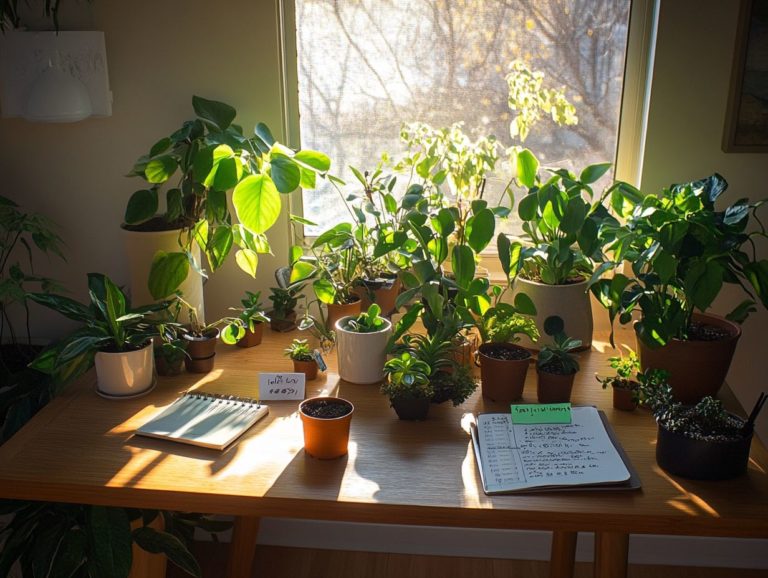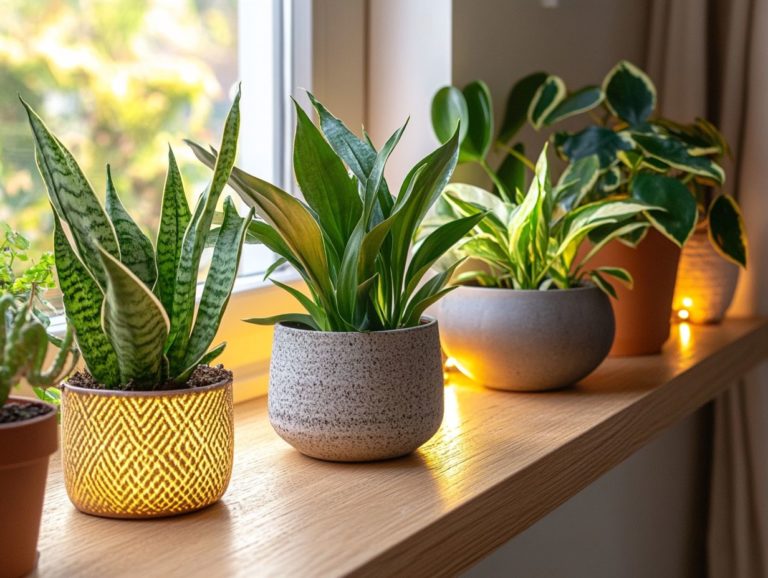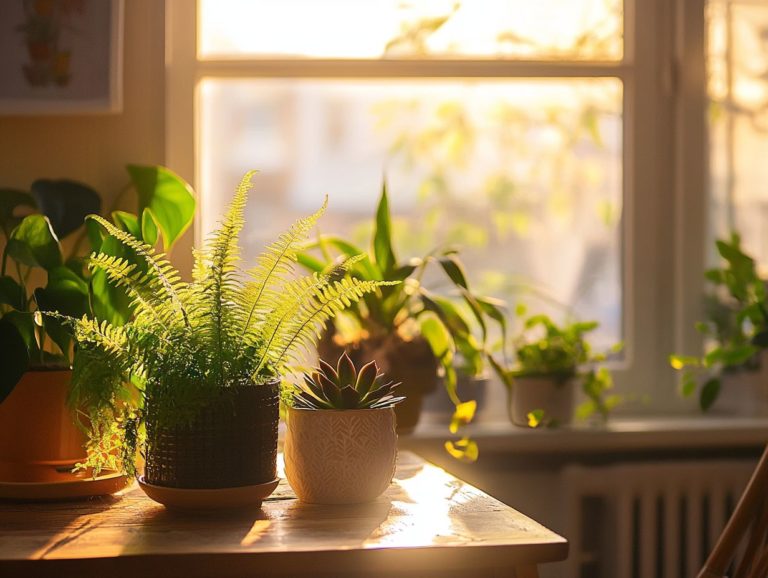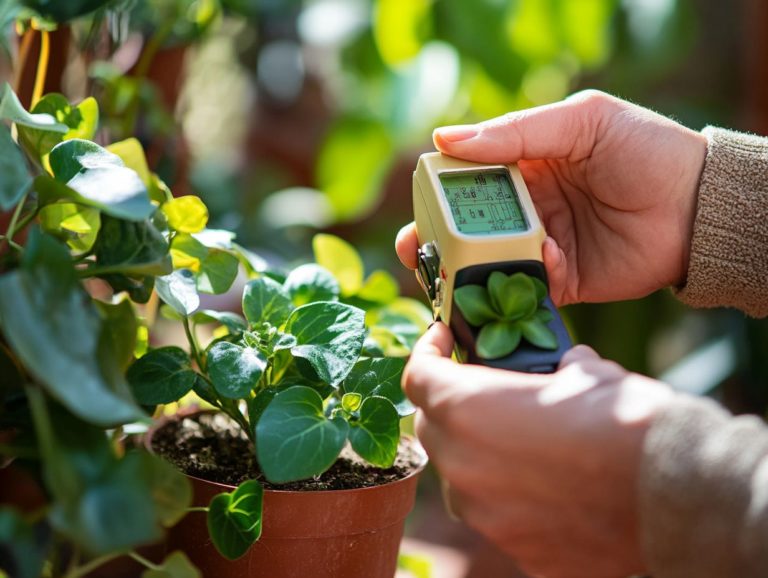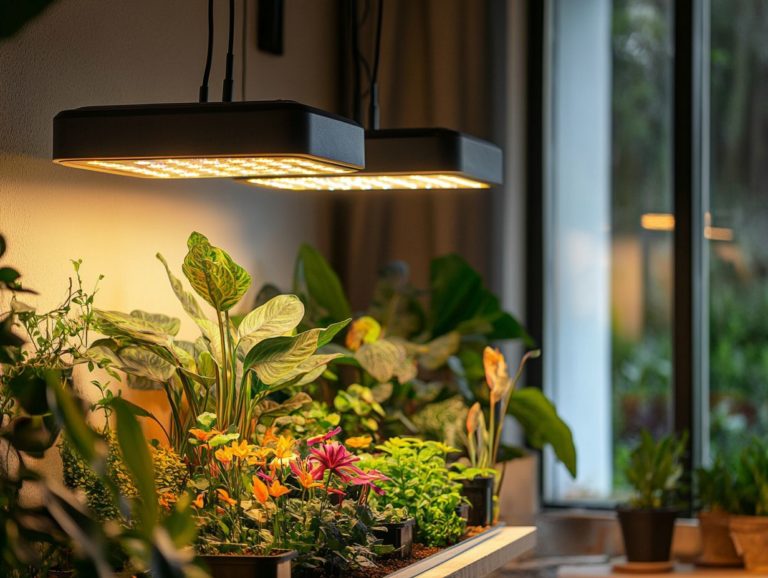How to Position Plants for Best Light
Understanding the light needs of your houseplants is essential for their growth and vitality. Get ready to transform your indoor gardening skills!
This article delves into the various factors that influence indoor plants growth, the specific types of light they require, and how you can assess the light levels in your home.
You ll discover practical tools for measuring light, the optimal levels for different plant species, and effective placement strategies to ensure your indoor gardening thrives.
Common light-related mistakes will be pointed out, along with additional tips for nurturing a healthy indoor garden with proper light exposure.
Let s dive in and unlock the secrets to thriving indoor plants!
Contents
- Key Takeaways:
- Understanding Plant Light Needs
- Assessing Light Levels in Your Home
- How to Position Plants for Best Light
- Common Mistakes and How to Avoid Them
- Additional Tips for Healthy Plant Growth
- Frequently Asked Questions
- How do I know which direction is best for positioning my plants for light?
- Can I position my plants too close to a window?
- What if I don’t have any windows in my home?
- Do all plants require the same amount of light?
- Can I rotate the position of my plants for better light distribution?
- What if my plant isn’t getting enough light in its current position?
Key Takeaways:
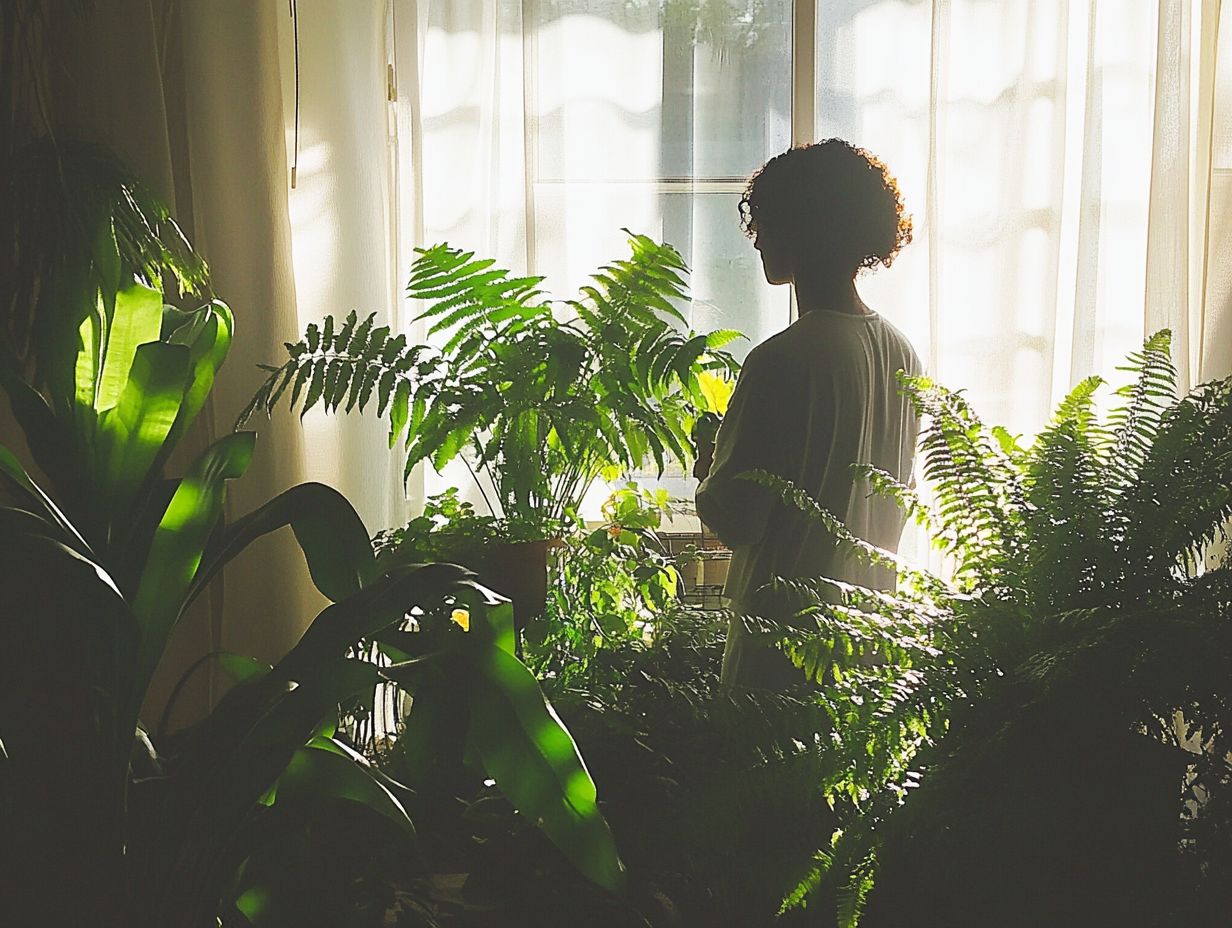
- Understand your plant’s light needs by considering factors such as natural light, intensity, and duration of exposure.
- Assess light levels in your home using tools like a light meter, and position plants accordingly for optimal growth.
- Avoid common mistakes like overexposure or underexposure to light by considering factors like proximity to windows and rotating plants for even light distribution.
Understanding Plant Light Needs
Understanding the light needs of your plants is essential for their overall health and vibrant growth, especially when you’re bringing houseplants into your indoor gardening setup. The intensity and quality of light can vary dramatically due to factors like room orientation, window treatments, and seasonal changes, all of which influence how well your plants will thrive.
By identifying whether your space receives north, south, east, or west light, you can tailor your approach to meet the specific needs of tropical vegetation and other indoor plants. This guide will clarify the essential light conditions your plants require for optimal health.
Factors that Affect Plant Growth
Several factors play a pivotal role in influencing plant growth, with light intensity and exposure ranking among the most critical. Understanding how these elements interact with watering schedules, temperature variations, and pest management is crucial for cultivating a flourishing indoor garden.
Each species possesses unique requirements, and recognizing these needs can help you sidestep common pitfalls in houseplant care. For instance, succulents and cacti thrive under bright, direct sunlight, making them perfect candidates for those sunny windowsills. In contrast, ferns and peace lilies prefer the embrace of lower light, flourishing in shadier corners.
Tailor your watering habits based on light exposure for optimal health; brighter conditions may necessitate more frequent watering, whereas lower light environments call for a more measured approach. Maintaining a stable temperature ideally between 65 F to 75 F will further enhance growth.
Keep a vigilant eye out for pests like spider mites and aphids, which can flourish in fluctuating temperatures. Early intervention with neem oil or insecticidal soap can effectively keep these nuisances at bay.
Types of Light for Plants
Understanding the various types of light available for your plants is essential for crafting the ideal indoor gardening environment and enhancing the process plants use to make food. You can categorize plants based on their light requirements: bright light, medium light, and low light, each offering distinct growth potential.
Direct sunlight, indirect sunlight, and fluorescent light all contribute uniquely to photosynthesis and the overall health of your plants.
Bright light is a must for sun-loving varieties like succulents and cacti; these plants flourish with unobstructed sunlight for most of the day. In contrast, medium light conditions are perfect for plants such as pothos and spider plants, which thrive near windows that provide filtered light. Low-light conditions are well-suited for hardy species like snake plants and ZZ plants, making them ideal for spaces with minimal daylight.
To optimize the lighting in your home, position your plants according to their specific needs, use sheer curtains to soften harsh sunlight, and even consider supplementing with grow lights. These strategies, along with the best light arrangements for houseplants, can dramatically enhance your plants’ growth and vitality.
Assessing Light Levels in Your Home
Assessing the light levels in your home is crucial for ensuring your plants receive the optimal amount of light they need for healthy growth and development. Consider factors such as the orientation of your windows, the presence of shadows, and seasonal changes. These elements can greatly influence light availability in your space.
By understanding these variables, you can make well-informed decisions about where to place your plants and how to care for them. This will ultimately help them flourish in their environment.
Tools for Measuring Light
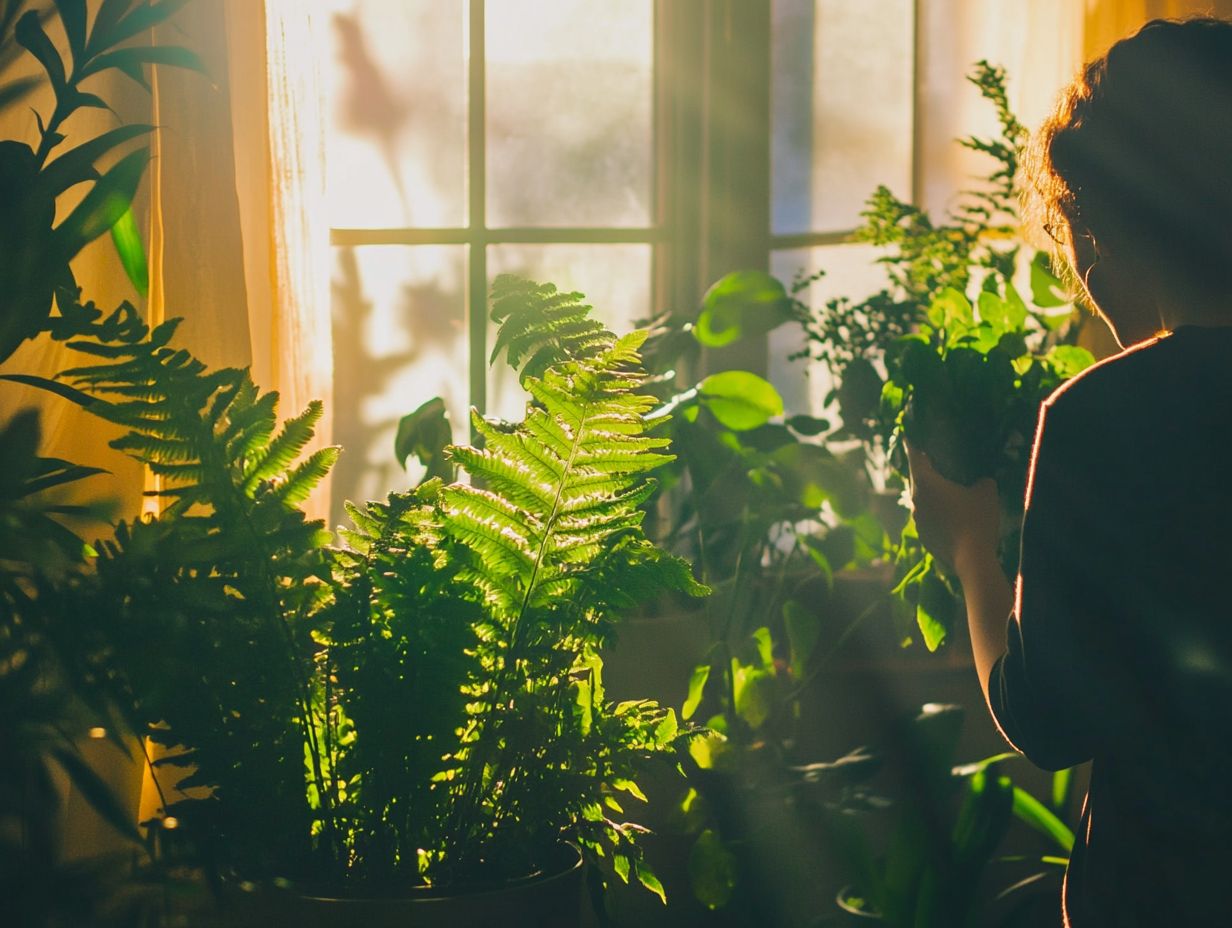
Using the right tools can boost your indoor gardening. They create the best conditions for your plants to thrive. Whether it s light meters, smartphone apps, or simple observational techniques, these tools help you determine the actual light levels your plants receive. This enables you to make necessary adjustments in placement and care.
Understanding how much light each plant requires helps you craft a thriving environment tailored specifically to its light needs. For instance, light meters provide precise readings in foot-candles (a measure of light intensity) or lux (the amount of light per unit area), giving you a quantifiable measure of your space’s lighting. If you opt for smartphone apps, ensure they are properly calibrated for enhanced accuracy.
Observing your plants responses can also be effective. Yellowing leaves or elongated stems often signal insufficient light. By regularly monitoring and adjusting the light conditions based on these insights, you re setting the stage for lush growth and vibrant health in your plants.
Optimal Light Levels for Different Plants
Understanding the optimal light levels for your plants is essential for ensuring they thrive. Each species comes with unique light requirements some bask in bright light, while others prefer the gentler embrace of lower light conditions. Aligning your plants’ needs with available light enhances their growth and overall vitality.
For instance, succulents and cacti demand direct sunlight for several hours each day, making them perfect candidates for south-facing windows. In contrast, ferns and peace lilies excel in indirect light, making them ideal for shadier corners of your living room.
To streamline this process, consider categorizing your plants based on their light preferences. You can create a simple chart that outlines each species’ needs, such as Low Light for Snake Plants , Medium Light for Pothos , and High Light for Fiddle Leaf Fig . For more information on how to provide the right conditions, check out these tips for effective plant lighting. This helps ensure each plant receives the specific care it needs to flourish.
How to Position Plants for Best Light
Positioning your plants with intention is essential for maximizing their exposure to light and creating ideal conditions for growth. Consider factors such as the orientation of your windows, existing room decor, and seasonal changes as you arrange your indoor garden.
This thoughtful placement helps you avoid common pitfalls like overexposure or underexposure. This will ultimately allow your plants to flourish.
Factors to Consider
When positioning your plants for optimal light exposure, consider several factors, including the room’s layout and existing window treatments. These elements create the overall environment in which your plants thrive, directly impacting their health and growth potential.
Noticing the natural light patterns throughout the day can help you determine the best plant placements. Some plants may bask happily in bright, direct sunlight, while others prefer a more subdued, indirect light. Understanding using sunlight for indoor plants effectively can enhance growth, especially in areas where natural light is scarce. The type of artificial lighting you use also matters, whether it’s fluorescent or LED.
Don’t overlook seasonal variations. As the sun’s angle changes, so do shadows and light intensity in your space. This requires you to adjust plant positions periodically to ensure each one receives adequate exposure throughout the year. For tips on this, check out how to position plants in your home.
Strategies for Placement
Ready to turn your indoor space into a vibrant green haven? Let s dive into some effective strategies for plant placement that can significantly enhance the success and health of your indoor gardening efforts. By understanding the unique light needs of various houseplants and experimenting with different arrangements, you can create an environment where they truly thrive.
Start by grouping plants with similar light needs together based on their exposure and requirements. This simple adjustment ensures that each plant gets enough sunlight throughout the day. To enhance this further, learn how to rotate plants for even light, effectively creating a microclimate that boosts their growth.
Consider rotating your plants regularly; this technique is both straightforward and powerful. It allows all sides of each specimen to receive adequate light, promoting balanced growth and preventing unsightly stretching that occurs when only one side gets illuminated.
Utilizing reflective surfaces, such as mirrors or light-colored walls, can also amplify light exposure without the need for artificial lighting. By bouncing light back onto the plants, you enhance their overall health.
These strategies can transform any indoor space into a flourishing green sanctuary.
Common Mistakes and How to Avoid Them
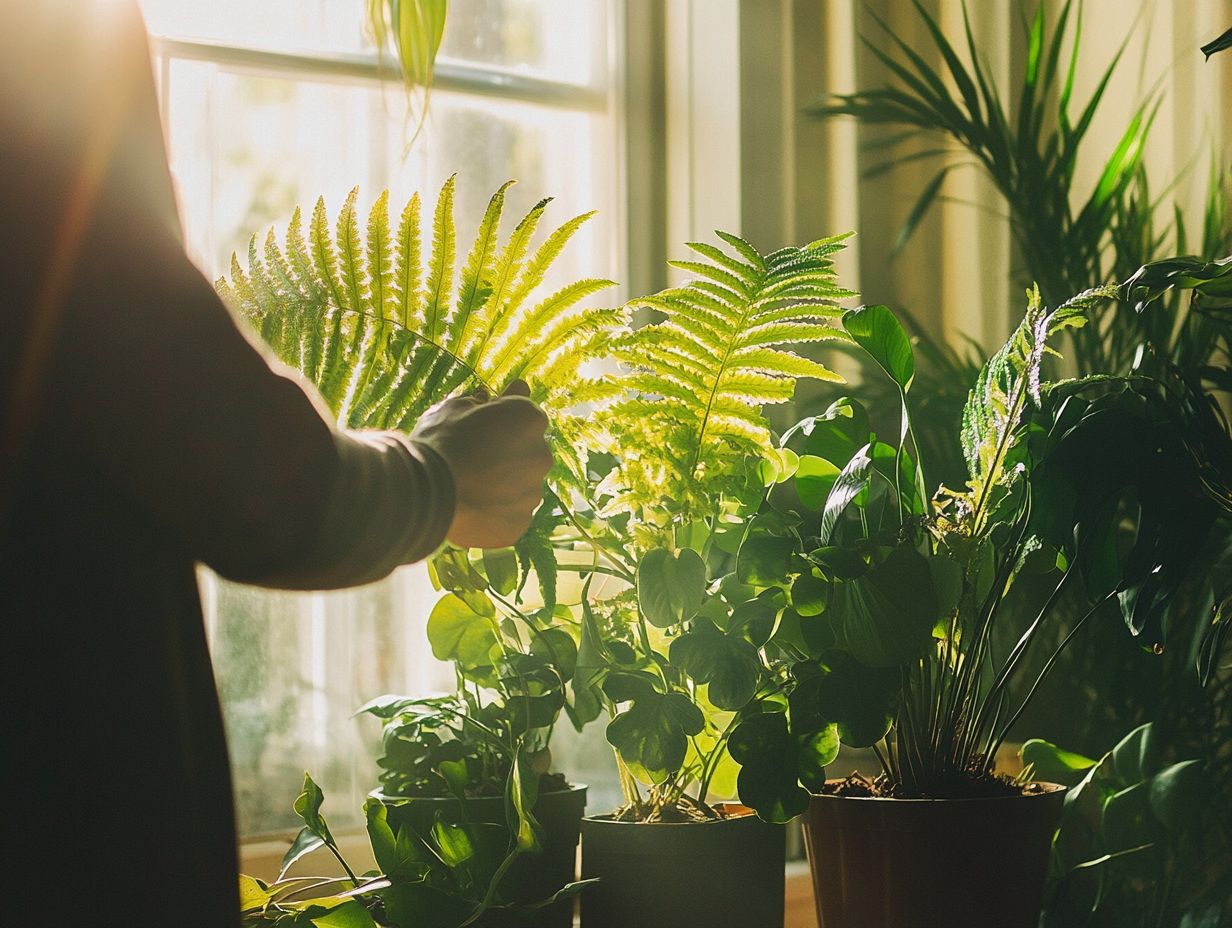
Avoiding common mistakes related to light exposure is essential for ensuring the longevity and health of your indoor plants. Misunderstanding their light needs can result in significant challenges, such as overexposure or underexposure, both of which can seriously impact their growth.
By paying close attention to your plants’ specific needs, you can create a healthy indoor garden that flourishes beautifully.
Overexposure to Light
Act quickly to ensure your plants thrive recognizing the signs of overexposure is key! Overexposure to light can pose a serious threat to your plants’ health, leading to issues like leaf scorch, wilting, and lackluster growth. It s crucial for you to recognize the signs of overexposure in order to maintain a flourishing indoor garden.
Certain species, especially those with delicate leaves like ferns and some tropical varieties, are particularly vulnerable to this challenge. You might notice brown tips or patches on the leaves, signaling that your plant is struggling to handle the intense brightness.
To reduce these risks, it’s wise to gradually acclimate your plants to brighter conditions, especially when transitioning them from a low-light environment to one that’s more illuminated. Understanding indoor plant light needs can help in adjusting their placement, like moving them a few feet away from direct sunlight or employing sheer curtains to diffuse harsh light, creating a more balanced exposure and fostering healthy growth without the burden of overexposure.
Underexposure to Light
Underexposure to light can significantly impede plant growth, resulting in elongated stems, pale leaves, and an overall decline in health. Identifying plants that flourish in low-light conditions is essential for cultivating a balanced indoor gardening setup that accommodates various light needs.
It s equally vital to recognize the signs indicating that more light-hungry species are suffering. These plants may exhibit slowed growth rates, shriveled leaves, and a noticeable lack of vigor in their development.
By keenly observing these symptoms, you can take proactive measures to revive your plants. For instance, relocating them to brighter spots or supplementing natural light with grow lights can dramatically boost their vitality. Regularly rotating your plants ensures that all sides receive adequate light exposure, creating a healthier growth environment.
Ultimately, grasping the specific light needs of each plant will lead you to a flourishing indoor garden.
Additional Tips for Healthy Plant Growth
In addition to understanding light needs and positioning, there are several key insights that can substantially elevate the healthy growth of your indoor plants.
Elements such as humidity, temperature, and consistent care routines are crucial in establishing an optimal environment where your plants can truly flourish.
Other Factors to Consider
Beyond light exposure, factors like humidity and temperature significantly impact your indoor garden’s health. By keeping these conditions in check, you can support your plants’ needs and help them flourish.
Temperature is vital for the growth of different plant species. Tropical plants thrive with humidity levels between 60% and 80%. In contrast, succulents and cacti prefer drier environments and need less humidity to stay healthy.
To maintain these ideal conditions, use a device that measures moisture in the air and an appropriate heater or air conditioner to control temperature. Remember to check the light your plants receive too much direct sunlight can lead to leaf burn, while too little can stunt their growth.
Finding the perfect balance is the secret to a thriving indoor garden!
Frequently Asked Questions
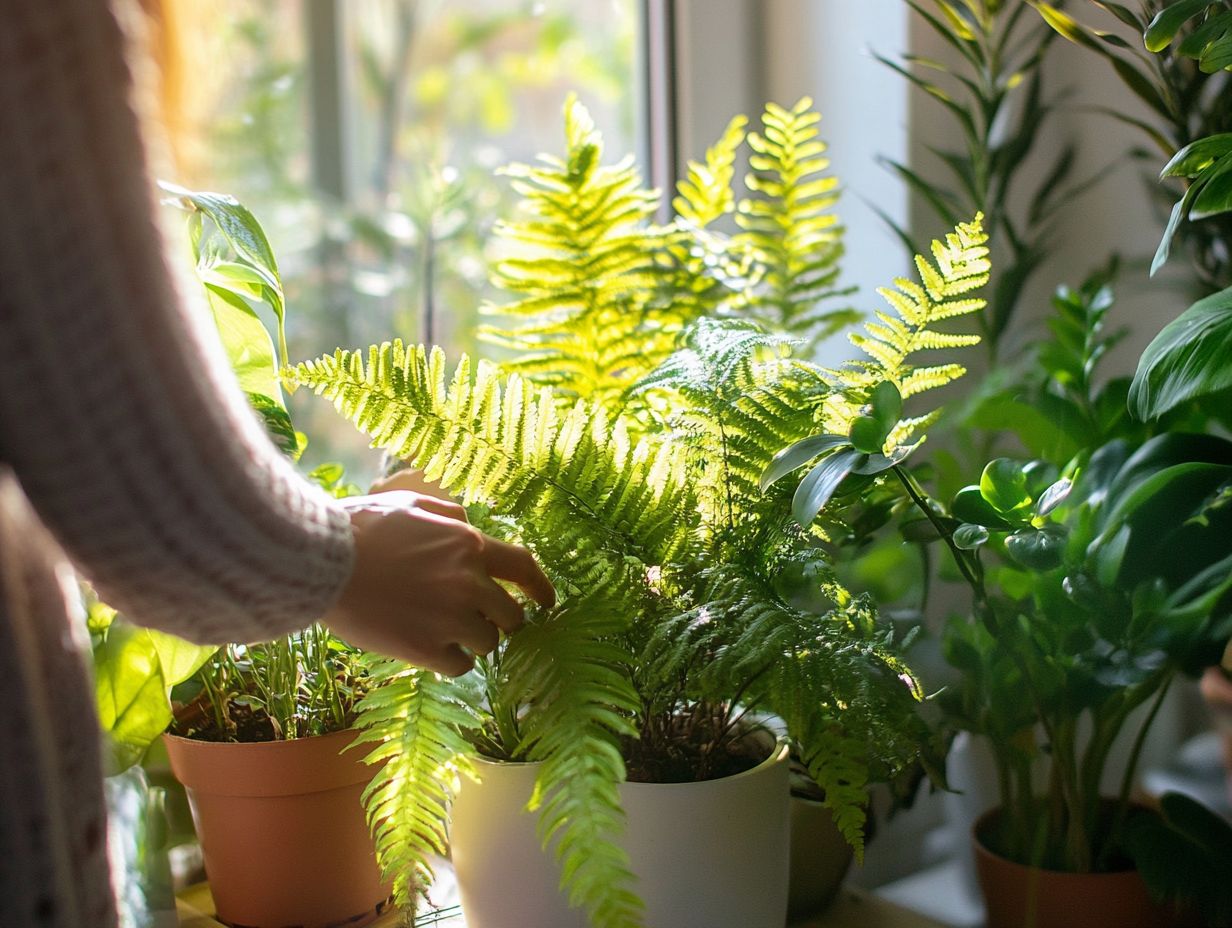
How do I know which direction is best for positioning my plants for light?
The best direction for light depends on the type of plant you have. Generally, south-facing windows provide the most light, followed by west-facing and east-facing. North-facing windows typically have the least light.
Can I position my plants too close to a window?
Yes, plants can receive too much direct sunlight if they’re too close to a window. Some plants handle more light than others, so it’s essential to research the specific needs of your plant before deciding on its placement.
What if I don’t have any windows in my home?
If you lack windows, you can still provide adequate light using grow lights. These artificial lights mimic natural sunlight and can be adjusted to meet your plants’ specific needs.
Do all plants require the same amount of light?
No, different plants have varying light requirements. Some, like succulents, prefer bright indirect light, while others, like ferns, thrive in low light. It’s important to research each plant’s needs before placement.
Can I rotate the position of my plants for better light distribution?
Yes! Rotating your plants helps ensure all parts receive adequate light. This is especially important for plants that tend to grow towards the light source, promoting more balanced growth.
What if my plant isn’t getting enough light in its current position?
If your plant isn’t thriving, it might not be getting enough light. Try moving it to a location with better lighting or supplementing with artificial grow lights.
Don’t let your plants miss out on the right light they deserve the best care possible! Share your gardening experiences and tips with us!


